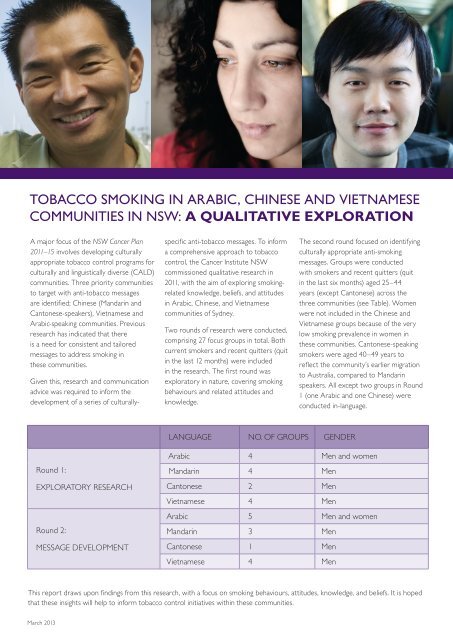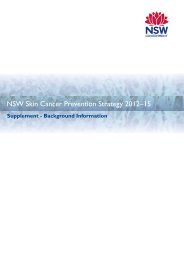tobacco smoking in arabic, chinese and vietnamese communities in ...
tobacco smoking in arabic, chinese and vietnamese communities in ...
tobacco smoking in arabic, chinese and vietnamese communities in ...
Create successful ePaper yourself
Turn your PDF publications into a flip-book with our unique Google optimized e-Paper software.
TOBACCO SMOKING IN ARABIC, CHINESE AND VIETNAMESE<br />
COMMUNITIES IN NSW: A QUALITATIVE EXPLORATION<br />
A major focus of the NSW Cancer Plan<br />
2011–15 <strong>in</strong>volves develop<strong>in</strong>g culturally<br />
appropriate <strong>tobacco</strong> control programs for<br />
culturally <strong>and</strong> l<strong>in</strong>guistically diverse (CALD)<br />
<strong>communities</strong>. Three priority <strong>communities</strong><br />
to target with anti-<strong>tobacco</strong> messages<br />
are identified; Ch<strong>in</strong>ese (M<strong>and</strong>ar<strong>in</strong> <strong>and</strong><br />
Cantonese-speakers), Vietnamese <strong>and</strong><br />
Arabic-speak<strong>in</strong>g <strong>communities</strong>. Previous<br />
research has <strong>in</strong>dicated that there<br />
is a need for consistent <strong>and</strong> tailored<br />
messages to address <strong>smok<strong>in</strong>g</strong> <strong>in</strong><br />
these <strong>communities</strong>.<br />
Given this, research <strong>and</strong> communication<br />
advice was required to <strong>in</strong>form the<br />
development of a series of culturallyspecific<br />
anti-<strong>tobacco</strong> messages. To <strong>in</strong>form<br />
a comprehensive approach to <strong>tobacco</strong><br />
control, the Cancer Institute NSW<br />
commissioned qualitative research <strong>in</strong><br />
2011, with the aim of explor<strong>in</strong>g <strong>smok<strong>in</strong>g</strong>related<br />
knowledge, beliefs, <strong>and</strong> attitudes<br />
<strong>in</strong> Arabic, Ch<strong>in</strong>ese, <strong>and</strong> Vietnamese<br />
<strong>communities</strong> of Sydney.<br />
Two rounds of research were conducted,<br />
compris<strong>in</strong>g 27 focus groups <strong>in</strong> total. Both<br />
current smokers <strong>and</strong> recent quitters (quit<br />
<strong>in</strong> the last 12 months) were <strong>in</strong>cluded<br />
<strong>in</strong> the research. The first round was<br />
exploratory <strong>in</strong> nature, cover<strong>in</strong>g <strong>smok<strong>in</strong>g</strong><br />
behaviours <strong>and</strong> related attitudes <strong>and</strong><br />
knowledge.<br />
The second round focused on identify<strong>in</strong>g<br />
culturally appropriate anti-<strong>smok<strong>in</strong>g</strong><br />
messages. Groups were conducted<br />
with smokers <strong>and</strong> recent quitters (quit<br />
<strong>in</strong> the last six months) aged 25–44<br />
years (except Cantonese) across the<br />
three <strong>communities</strong> (see Table). Women<br />
were not <strong>in</strong>cluded <strong>in</strong> the Ch<strong>in</strong>ese <strong>and</strong><br />
Vietnamese groups because of the very<br />
low <strong>smok<strong>in</strong>g</strong> prevalence <strong>in</strong> women <strong>in</strong><br />
these <strong>communities</strong>. Cantonese-speak<strong>in</strong>g<br />
smokers were aged 40–49 years to<br />
reflect the community’s earlier migration<br />
to Australia, compared to M<strong>and</strong>ar<strong>in</strong><br />
speakers. All except two groups <strong>in</strong> Round<br />
1 (one Arabic <strong>and</strong> one Ch<strong>in</strong>ese) were<br />
conducted <strong>in</strong>-language.<br />
LANGUAGE NO. OF GROUPS GENDER<br />
Round 1:<br />
EXPLORATORY RESEARCH<br />
Round 2:<br />
MESSAGE DEVELOPMENT<br />
Arabic 4 Men <strong>and</strong> women<br />
M<strong>and</strong>ar<strong>in</strong> 4 Men<br />
Cantonese 2 Men<br />
Vietnamese 4 Men<br />
Arabic 5 Men <strong>and</strong> women<br />
M<strong>and</strong>ar<strong>in</strong> 3 Men<br />
Cantonese 1 Men<br />
Vietnamese 4 Men<br />
This report draws upon f<strong>in</strong>d<strong>in</strong>gs from this research, with a focus on <strong>smok<strong>in</strong>g</strong> behaviours, attitudes, knowledge, <strong>and</strong> beliefs. It is hoped<br />
that these <strong>in</strong>sights will help to <strong>in</strong>form <strong>tobacco</strong> control <strong>in</strong>itiatives with<strong>in</strong> these <strong>communities</strong>.<br />
March 2013
TOBACCO SMOKING IN CALD COMMUNITIES:<br />
SUMMARY OF FINDINGS<br />
SMOKING BEHAVIOURS<br />
AND ATTITUDES<br />
In Australia, smokers were thought to<br />
be a m<strong>in</strong>ority, with <strong>smok<strong>in</strong>g</strong> behaviour<br />
disapproved of by the community as a<br />
whole. In contrast, <strong>smok<strong>in</strong>g</strong> was thought<br />
to be common place <strong>and</strong> traditional <strong>in</strong><br />
the country of orig<strong>in</strong>. This association has<br />
largely carried across to the <strong>in</strong>dividual<br />
<strong>communities</strong> now <strong>in</strong> Australia with CALD<br />
smokers aware that <strong>smok<strong>in</strong>g</strong> prevalence<br />
is greater <strong>in</strong> their <strong>communities</strong> than <strong>in</strong> the<br />
general population. However, for most,<br />
this was not a concern as <strong>smok<strong>in</strong>g</strong> was<br />
viewed as an <strong>in</strong>tegral part of their culture.<br />
“But it is the Vietnamese culture<br />
that men <strong>and</strong> young men smoke.<br />
They have grown up this way.<br />
Most of the men <strong>in</strong> the family<br />
smoked, gr<strong>and</strong>fathers, fathers,<br />
uncles, older brothers, so it’s just<br />
the way it is.”<br />
(Vietnamese, male, 25–44 years).<br />
Smok<strong>in</strong>g was generally a highly emotive issue,<br />
with smokers associat<strong>in</strong>g their habit with<br />
feel<strong>in</strong>gs of guilt, affection, ostracism,<br />
relaxation <strong>and</strong> helplessness. It<br />
was also perceived by smokers<br />
as be<strong>in</strong>g a very social behaviour.<br />
“Yeah, you feel cool. It helps<br />
with socialis<strong>in</strong>g <strong>and</strong> helps with<br />
communication, break<strong>in</strong>g the<br />
ice with new people. It’s a bond<br />
between people. A cigarette is<br />
someth<strong>in</strong>g you have <strong>in</strong> common<br />
with other people, br<strong>in</strong>gs you<br />
together.”<br />
(M<strong>and</strong>ar<strong>in</strong>, male, 25–34 years).<br />
“It’s a getaway... it relaxes you <strong>and</strong><br />
makes you feel special.”<br />
(Arabic, female, 25–44 years).<br />
The regulatory environment of Australia,<br />
particularly restrictions on <strong>smok<strong>in</strong>g</strong> <strong>in</strong> public<br />
places, has had an <strong>in</strong>fluence on <strong>smok<strong>in</strong>g</strong><br />
behaviour, <strong>in</strong> particular through the reduced<br />
March 2013<br />
opportunity to smoke. However, CALD<br />
smokers perceived such restrictions to<br />
be more about environmental <strong>and</strong> social<br />
cleanl<strong>in</strong>ess <strong>and</strong> government control of<br />
behaviour rather than be<strong>in</strong>g associated with<br />
the dangers of <strong>smok<strong>in</strong>g</strong> <strong>and</strong> reduc<strong>in</strong>g the<br />
burden on the health system.<br />
Many male participants, particularly those<br />
from Ch<strong>in</strong>ese or Vietnamese backgrounds,<br />
claimed that women were more likely to<br />
smoke <strong>in</strong> Australia than <strong>in</strong> their country of<br />
orig<strong>in</strong>. Arabic-speak<strong>in</strong>g women re<strong>in</strong>forced<br />
this view, with the perception that there is<br />
greater gender equality <strong>in</strong> Australia <strong>and</strong> the<br />
correspond<strong>in</strong>g change <strong>in</strong> role for women<br />
be<strong>in</strong>g cited as possible reasons for this.<br />
There was also a common assertion that<br />
<strong>smok<strong>in</strong>g</strong> by women was done as a result<br />
of feel<strong>in</strong>gs of lonel<strong>in</strong>ess <strong>and</strong> social isolation.<br />
“Life is very bor<strong>in</strong>g here, we<br />
have noth<strong>in</strong>g to do here, there<br />
are no pleasures. Smok<strong>in</strong>g<br />
becomes someth<strong>in</strong>g to ‘lift’ you,<br />
<strong>and</strong> a habit too!”<br />
(Arabic, female, 35–44 years).<br />
For Arabic smokers, particularly women,<br />
sheesha (waterpipe <strong>tobacco</strong>) was seen as<br />
a very social activity with strong cultural<br />
relevance. Shar<strong>in</strong>g sheesha was seen as a<br />
good way of facilitat<strong>in</strong>g familial <strong>and</strong> social<br />
<strong>in</strong>teractions <strong>and</strong> was not often seen <strong>in</strong> the<br />
same light as <strong>smok<strong>in</strong>g</strong> cigarettes. Some<br />
participants believed that if you only smoked<br />
sheesha, then you were not a smoker.<br />
Similarly, there was some confusion about the<br />
health risk posed by sheesha <strong>in</strong> comparison<br />
to other <strong>tobacco</strong> <strong>smok<strong>in</strong>g</strong>.<br />
“Whenever we got<br />
together it [sheesha] was<br />
more of a social th<strong>in</strong>g<br />
to have together than<br />
cigarettes. I didn’t even<br />
th<strong>in</strong>k it was unhealthy.<br />
I only found out about<br />
it be<strong>in</strong>g a health risk<br />
recently.”<br />
(Arabic, female, 25–44 years).<br />
HEALTH EFFECTS<br />
OF SMOKING<br />
Participants generally accepted that <strong>smok<strong>in</strong>g</strong><br />
causes health problems, with lung cancer,<br />
heart disease, stroke, <strong>and</strong> emphysema all<br />
commonly recalled. However, it was clear<br />
that health consequences were not readily<br />
accepted as relevant to the <strong>in</strong>dividual smoker;<br />
very few people claimed to have modified<br />
their behaviour due to concern for their own<br />
health.<br />
Indeed, most smokers were reluctant to<br />
acknowledge that their own <strong>smok<strong>in</strong>g</strong> may<br />
cause them harm, <strong>in</strong>stead preferr<strong>in</strong>g to<br />
believe that they were generally healthy<br />
<strong>and</strong> that the more serious <strong>smok<strong>in</strong>g</strong>-related<br />
conditions would occur late <strong>in</strong> life, if they<br />
occurred at all.<br />
“Lung cancer is the worst. This<br />
does play on your m<strong>in</strong>d a bit if<br />
you are a long-time smoker!”<br />
(M<strong>and</strong>ar<strong>in</strong>, male, 35–44 years).<br />
In contrast, significant concern was directed<br />
at the potential health effects on their<br />
families, particularly children. This elevated<br />
concern about the health effects of secondh<strong>and</strong><br />
smoke was <strong>in</strong> direct contradiction with<br />
the level of concern about themselves. Many<br />
parents expressed a desire to not see their<br />
children smoke.<br />
“The most important reason<br />
which might make me want<br />
to quit <strong>smok<strong>in</strong>g</strong> would be my<br />
children <strong>and</strong> family. I fear<br />
<strong>smok<strong>in</strong>g</strong> would harm the health<br />
of my children.”<br />
(Vietnamese, male, 25–44 years).
SMOKING CESSATION<br />
Most participants readily acknowledged that<br />
quitt<strong>in</strong>g <strong>smok<strong>in</strong>g</strong> was someth<strong>in</strong>g that they<br />
should do, <strong>and</strong> many expected that at some<br />
stage <strong>in</strong> their life they would successfully quit.<br />
Most had already attempted to quit, though<br />
quitt<strong>in</strong>g was commonly seen as very difficult<br />
<strong>and</strong> someth<strong>in</strong>g to be tackled <strong>in</strong> the long term.<br />
Even among recent quitters, many conceded<br />
that the habit was hard to break <strong>and</strong> that<br />
they still get tempted to smoke when<br />
stressed or <strong>in</strong> particular social situations or<br />
sett<strong>in</strong>gs. In general, the benefits of <strong>smok<strong>in</strong>g</strong><br />
were seen to outweigh the negatives. This<br />
meant that quitt<strong>in</strong>g was not a priority,<br />
especially not for younger smokers <strong>in</strong> the<br />
Asian <strong>communities</strong>.<br />
Quitt<strong>in</strong>g motivations varied, with aspects<br />
such as negative health effects, ris<strong>in</strong>g costs,<br />
<strong>and</strong> role modell<strong>in</strong>g for children all frequently<br />
mentioned. Smokers tended not to dwell<br />
on the potential harm from <strong>smok<strong>in</strong>g</strong>, with<br />
younger smokers deny<strong>in</strong>g that it has any<br />
undesirable physical effects on them.<br />
Recent quitters were more aware of the<br />
negative consequences of <strong>smok<strong>in</strong>g</strong> <strong>and</strong> were<br />
more likely than smokers to accept concern<br />
about health as a reason to quit.<br />
For most participants, children <strong>and</strong> family<br />
were the prime motivation to quit. Changes<br />
<strong>in</strong> life stage (for example, start<strong>in</strong>g a new<br />
relationship or plann<strong>in</strong>g a pregnancy) may<br />
also trigger serious consideration of quitt<strong>in</strong>g.<br />
“I feel I let my family down when<br />
I am not quit or take it up aga<strong>in</strong>.”<br />
(Cantonese, male, 40–49 years).<br />
Barriers to quitt<strong>in</strong>g <strong>in</strong>cluded: denial; lack of<br />
willpower; personal problems; fear that social<br />
life will be lost; addiction;<strong>and</strong> poor awareness<br />
of support options available. While family<br />
was often cited as a reason not to smoke,<br />
there was also some sense that the stress of<br />
be<strong>in</strong>g a parent would actually be a barrier to<br />
quitt<strong>in</strong>g.<br />
“Even after I had kids, it<br />
[<strong>smok<strong>in</strong>g</strong>] was actually my time<br />
out. I looked forward to the<br />
cigarette <strong>and</strong> had even more.”<br />
(Arabic, female, 25–44 years).<br />
QUITTING SUPPORT<br />
Those who had quit most commonly<br />
reported go<strong>in</strong>g ‘cold turkey’; that is, without<br />
quitt<strong>in</strong>g aids. Some reported adopt<strong>in</strong>g<br />
specific cop<strong>in</strong>g strategies such as avoid<strong>in</strong>g or<br />
m<strong>in</strong>imis<strong>in</strong>g contact with smokers <strong>and</strong> <strong>smok<strong>in</strong>g</strong><br />
situations, seek<strong>in</strong>g support from family <strong>and</strong><br />
friends, <strong>and</strong> engag<strong>in</strong>g <strong>in</strong> other activities when<br />
crav<strong>in</strong>gs occurred. Arabic smokers were<br />
especially likely to mention seek<strong>in</strong>g support<br />
from friends or family.<br />
Willpower was considered an essential<br />
factor <strong>in</strong> quitt<strong>in</strong>g successfully, <strong>and</strong> without it<br />
smokers felt they would most certa<strong>in</strong>ly fail.<br />
“...no-one can really push me to<br />
quit except myself.”<br />
(M<strong>and</strong>ar<strong>in</strong>, male, 25–44 years).<br />
Only a few reported hav<strong>in</strong>g success with<br />
quitt<strong>in</strong>g aids such as nicot<strong>in</strong>e replacement<br />
therapy <strong>and</strong> prescribed medications. These<br />
sorts of aids were often considered too<br />
expensive, <strong>in</strong>effective or laden with side<br />
effects.<br />
While some had thought of us<strong>in</strong>g Quitl<strong>in</strong>e,<br />
very few had actually used it. There was poor<br />
knowledge of what it offered, <strong>in</strong>clud<strong>in</strong>g that<br />
the service is available <strong>in</strong> their language, <strong>and</strong> a<br />
general perception that the service would not<br />
be very helpful.<br />
ANTI SMOKING<br />
MESSAGING<br />
Mass media campaigns <strong>and</strong> graphic health<br />
warn<strong>in</strong>gs on packag<strong>in</strong>g were frequently<br />
mentioned as be<strong>in</strong>g motivat<strong>in</strong>g to quit,<br />
although the most effective style of message<br />
varied between the different <strong>communities</strong>,<br />
<strong>and</strong> even with<strong>in</strong> the <strong>communities</strong>. Graphic<br />
imagery, for example, was perceived as<br />
be<strong>in</strong>g effective by some, particularly <strong>in</strong> the<br />
Vietnamese community.<br />
“Like, we still smoke<br />
now, but those images<br />
keep lurk<strong>in</strong>g <strong>in</strong> our<br />
background, <strong>in</strong> our<br />
m<strong>in</strong>ds. It will make us<br />
stop sooner or later.”<br />
(Vietnamese, male, 25–44 years).<br />
For others, especially Arabic smokers,<br />
testimonial-style advertis<strong>in</strong>g was perceived<br />
as be<strong>in</strong>g the most effective. These ads<br />
engendered a strong sense of personal<br />
relevance <strong>and</strong> were thought to be<br />
emotionally <strong>in</strong>volv<strong>in</strong>g. For those <strong>in</strong> the<br />
Ch<strong>in</strong>ese community, there was a stated<br />
preference for ‘hard’ facts <strong>and</strong> educative<br />
approaches.<br />
However, it was evident that care needs<br />
to be taken when deliver<strong>in</strong>g these types<br />
of messages as there was a strong<br />
tendency among smokers to try <strong>and</strong> poke<br />
holes <strong>in</strong> any messag<strong>in</strong>g that conta<strong>in</strong>ed<br />
statistics. For example, when shown a<br />
message stat<strong>in</strong>g that 20% per cent of all<br />
cancer deaths are due to <strong>smok<strong>in</strong>g</strong>, some<br />
participants viewed this with scepticism:<br />
“If you stop <strong>smok<strong>in</strong>g</strong>, you might<br />
die from other causes anyway.”<br />
(Cantonese, male, 40–49 years).<br />
While both English-language <strong>and</strong> <strong>in</strong>-language<br />
advertis<strong>in</strong>g were mentioned, <strong>in</strong>-language<br />
advertis<strong>in</strong>g was clearly less top-of-m<strong>in</strong>d.<br />
However, it was apparent that a mix of<br />
English <strong>and</strong> <strong>in</strong>-language advertis<strong>in</strong>g would<br />
be most effective at reach<strong>in</strong>g smokers <strong>in</strong><br />
these <strong>communities</strong> as there was some<br />
sense of <strong>in</strong>creased personal relevance when<br />
advertis<strong>in</strong>g was presented <strong>in</strong> this way.
TOBACCO SMOKING IN ARABIC, CHINESE AND VIETNAMESE<br />
COMMUNITIES IN NSW: CONCLUSION<br />
From this research, it is clear that more needs to be done to address <strong>tobacco</strong> <strong>smok<strong>in</strong>g</strong> <strong>in</strong> the<br />
Sydney Arabic, Ch<strong>in</strong>ese, <strong>and</strong> Vietnamese <strong>communities</strong>.<br />
Quitt<strong>in</strong>g <strong>smok<strong>in</strong>g</strong>, while someth<strong>in</strong>g many participants thought they should do, appeared not to be<br />
a priority because of a lack of underst<strong>and</strong><strong>in</strong>g of personal susceptibility to <strong>smok<strong>in</strong>g</strong>-related diseases<br />
<strong>and</strong> because the cultural <strong>and</strong> social benefits of <strong>smok<strong>in</strong>g</strong> outweighed the perceived negatives.<br />
However, the messages tested as part of this research showed that provid<strong>in</strong>g more <strong>in</strong>formation on<br />
the health effects of <strong>smok<strong>in</strong>g</strong> to smokers <strong>in</strong> these <strong>communities</strong> could have considerable impact.<br />
Care needs to be taken to ensure that appropriate styles of message delivery are used but if<br />
delivered effectively, <strong>in</strong> conjunction with ma<strong>in</strong>stream messag<strong>in</strong>g, <strong>and</strong> with appropriate support <strong>in</strong><br />
place, it was apparent that the motivation of many smokers could be dramatically <strong>in</strong>creased.<br />
SMOKING FACTS: MALE SMOKERS IN NSW<br />
NSW GENERAL<br />
14.7%<br />
CHINESE MEN<br />
20.3%<br />
VIETNAMESE MEN<br />
32.0%<br />
ARABIC MEN<br />
39.3%<br />
THE LANGUAGE SPECIFIC QUITLINE TELEPHONE NUMBERS ARE:<br />
ARABIC: 1300 7848 03<br />
CHINESE (CANTONESE AND MANDARIN): 1300 7848 36<br />
VIETNAMESE: 1300 7848 65<br />
KOREAN: 1300 7848 23<br />
www.icanquit.com.au<br />
www.cancer<strong>in</strong>stitute.org.au<br />
March 2013










